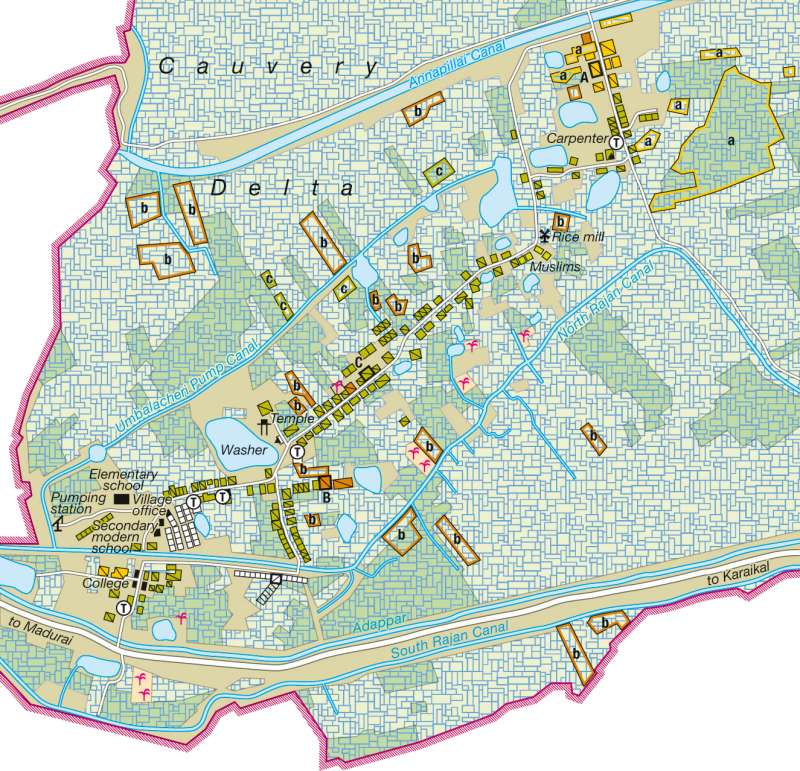Umbalacheri — Land ownership
Persian Gulf region
978-3-14-100790-9 | Page 105 | Ill. 5

Information
Even today, some 72 percent of the population of India live in villages; more than 60 percent of the working population earn their living from agriculture. The village of Umbalacheri is a typical South Indian farming village. It is situated 300 kilometres south of Madras in the canal irrigation system of the Cauvery Delta (compare maps on pages 164/165, 124/125) in the "rice bowl" of South India. The long street village is surrounded by rice fields, criss-crossed by a network of irrigation canals and ditches. The modern cultivation methods of the "green revolution", with their high-yield varieties and chemical fertilizers, making two harvests per year possible, have only prevailed to a limited extent in Umbalacheri. Traditional forms of cultivation dominate. The village, at the end of the irrigation system closest to the coast, suffers from water supply problems. As well as the settlement structure and cultivation situation, the map also shows the village's social structure (caste system), its economic actors (landowners, agricultural labourers) and their ownership relations (large farmers, small farmers).The Village Settlement and Social Structure
Umbalacheri is a typical Indian caste village. At the top of the social hierarchy are the Brahmins, traditionally the priests, who today are mostly large farmers. The example of Umbalacheri shows that also among this group there are some families without land. The majority of these Brahmins work outside the village as teachers or in government administration. Typical of them is spatial segregation, seen in the isolated situation of their dwellings at the ends of the village street.
Equally segregated, as a rule, are the quarters of the untouchables, the "Harijans". Only one of these owns a tiny parcel of land; all the others hire themselves out as agricultural labourers. Their work situation is characterized by chronic underemployment. The low incomes earned from farm labour make the group of untouchables into the poor of Umbalacheri.
But even among the farming castes there are landless people and very small farmers who are classified as living in absolute poverty. They compete with the untouchables for the limited available work. Many of them are in a relationship of dependence on the large farmers, who loan them money when they need it and demand high rates of interest. The substantial proportion of the landless among the farming castes is an indication of how small farmers are forced to sell their land to the money lenders when they fall into debt, and thus become reduced to agricultural labourers. The extreme fragmentation of land ownership — the small farmers in particular often possess large numbers of tiny parcels of land scattered across the entire district — is a hindrance to rational farming of the land.
Problems of Agrarian Development
The Cauvery Delta is actually one of those regions of South India where the "green revolution", with its high-yield varieties, artificial fertilizers and modern well irrigation, caught on particularly early and rapidly. Within a few years after the start of the "green revolution" at the end of the 1960s, rice production figures in the delta region doubled. The basis for the success was the thoroughly favourable irrigation possibilities.
The fact that the village of Umbalacheri has only participated in the "green revolution" to a limited degree, and that even today only a part of the cultivated area is given over to high-yield varieties, is mainly due to the canal irrigation being inadequate and often coming too late. The reason for this is the village's location at the lower end of the irrigation system closest to the coast, and the fact that the farmers in the upper parts of the delta often use a disproportionate amount of water at the expense of those in the lower parts. Umbalacheri also frequently suffers from flooding when autumn cyclones drive seawater into the irrigation canals.
H.-G. Bohle; Ü: J. Attfield




